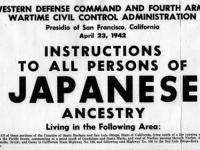Asian immigration to the United States has, until recently, been limited. The New World was settled primarily by Europeans and the majority wished to keep it that way. That is why the Chinese, after they helped build the Central Pacific Railroad, were excluded from immigrating to the United States by an 1882 act of Congress. Similarly, by the notorious "Gentlemen's Agreement" of 1907, the government of Japan agreed to limit the emigration of its people to this country. Californians, who resented the phenomenal success of Japanese farmers, were thus mollified.
When World War II broke out, anti-Japanese feeling in California, which had always been high, exploded. Rather than take the lead in cooling passions, the federal government gave in to nativist demands to intern an entire ethnic group. Not since American Indians had been rounded up and forced onto reservations had the United States government committed such an injustice.
The Balch Institute for Ethnic Studies presents this exhibit on "The Japanese American Experience" with a mixture of pride and shame. Shame at what our government did to Japanese Americans during World War II. Pride at how these people, in spite of all the injustices inflicted upon them, overcame their difficulties and eventually became one of America's most successful ethnic groups. Japanese Americans, as our exhibits demonstrate, stand as a model of perseverance in the face of adversity. These are qualities that we can all emulate.
Learn more about the Japanese-American Experience

